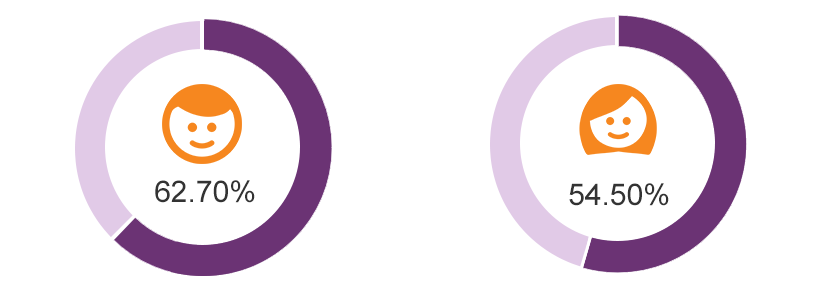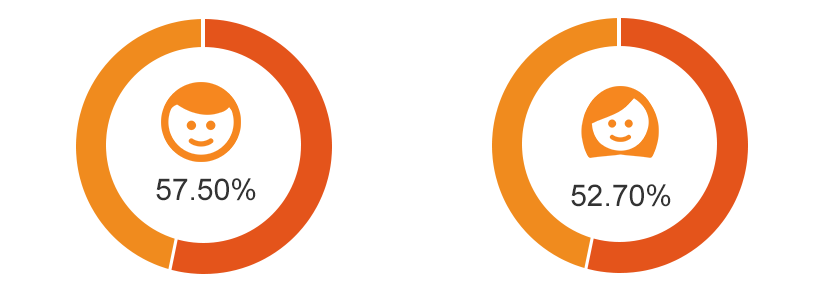From April 2018, all employers with 250 colleagues or more are required by law to publish the pay and bonus gap between men and women. The gender pay gap is the difference between the average earnings of men and women, irrespective of their role or seniority. It only, therefore, captures pay differences on a broad level.
The gender pay gap shows the differences between the means (average), the medians (mid-point) of pay and bonus earnings of male and female colleagues, expressed as a percentage of male colleague’s earnings.
Pay gap
Below is our gender pay gap information based on the April 2018 payroll for the 1,324 relevant colleagues within the charity.
| In comparison to men
|
April 2018
|
April 2017
|
|
 women's mean hourly rate is women's mean hourly rate is
|
8.3% lower
|
7.8% lower
(UK average 17.4%)
|
 women's median hourly rate is women's median hourly rate is
|
0.6% lower
|
0.7% lower
(UK average 18.4%)
|
Our pay gap continues to be smaller than in most other organisations in the UK and is broadly unchanged from last year.
The slight increase in the mean pay gap is due to our recruitment during the year resulting in more women in front line roles, and an increase in men in technical IT roles that attract a higher salary.
Our median pay is almost equal.
Pay quartiles
Overall, 54.8% of colleagues are female and 45.2% are male; a reasonably balanced population. However, the concentration of women is higher than men in all quartiles except for the highest pay quartile where men occupy 52.6% of roles.
We recognise that science, technology, engineering and mathematics qualifications (STEM) are more likely to be required for technical and senior roles within the charity that attract higher salaries.
Fewer women graduate in STEM subjects than men and this creates a less diverse candidate pool for us to recruit from.
The charts below show the proportion of men and women in each of the pay quartiles and how the pay quartiles compare against the previous year.
2018

2017

Bonus gap
All colleagues, except directors, are eligible for bonus if they meet pre-defined eligibility criteria. Bonus for the year to April 2018, required an employment start date prior to 1 March 2017, achievement of attendance levels and achievement of performance standards.
Bonus criteria were deemed fair and appropriate and were consistently applied across the charity. Our bonus gap for the 12 months ending April 2018 is as follows:
| In comparison to men
|
to April 2018
|
to April 2017
|
|
 women's mean bonus pay is women's mean bonus pay is
|
9.5% lower
|
7.1% lower
|
 women's median bonus pay is women's median bonus pay is
|
17.3% lower
|
14.1% lower
|
Our results show that the gap in bonus payments between men and women has grown from last year. There are two main reasons for this:
- Bonus payment during the year was prorated according to working hours and the proportion of women working part time is higher than men. This resulted in men receiving a higher average bonus payment
- A bonus was paid for attendance achieved during part of the year. During the period covered, the attendance achieved by men was higher than women, which led to higher bonus. The attendance bonus has since been replaced by an alternative bonus arrangement.
Proportion of colleagues receiving a bonus
More of our colleagues received a bonus during the year to April 2018 than in the previous year, with increases in the proportion of both men and women receiving a bonus. However, there is still a gap in the proportion of men and women who received a bonus in the 2018 reporting year.
The reason for this is:
- The eligibility criteria for the bonus stated that colleagues had to be in post before 1 March in order to qualify. There was a higher proportion of women starting employment after the 1 March.
- The bonus was linked to attendance and colleagues had to have an attendance level above a certain percentage to qualify. There were more women than men who did not qualify for the bonus on this basis.
2018

2017

Our approach
- We're committed to creating a diverse workforce where gender balance is evident at all levels across the charity.
- We continually monitor and review our practices to ensure that we attract, recruit, retain, reward, develop and promote the best talent.
- We recognise that increasing the diversity of the talent pool for technical and senior roles will take time.
- We'll always aim to recruit, reward, develop and promote based on merit.
Read the previous year's report